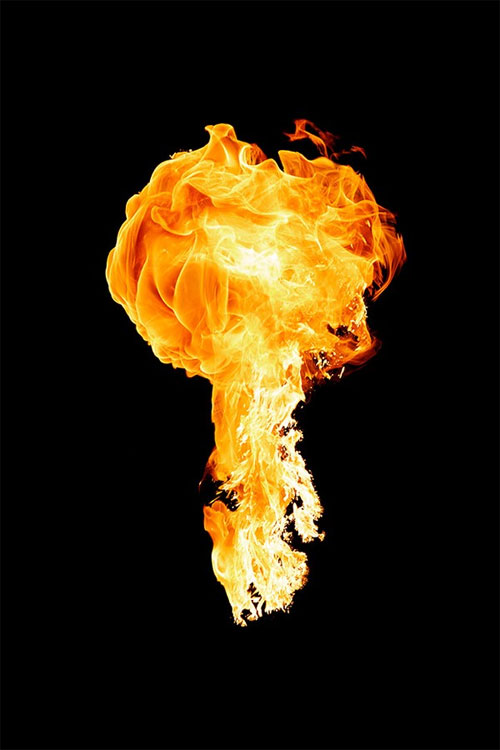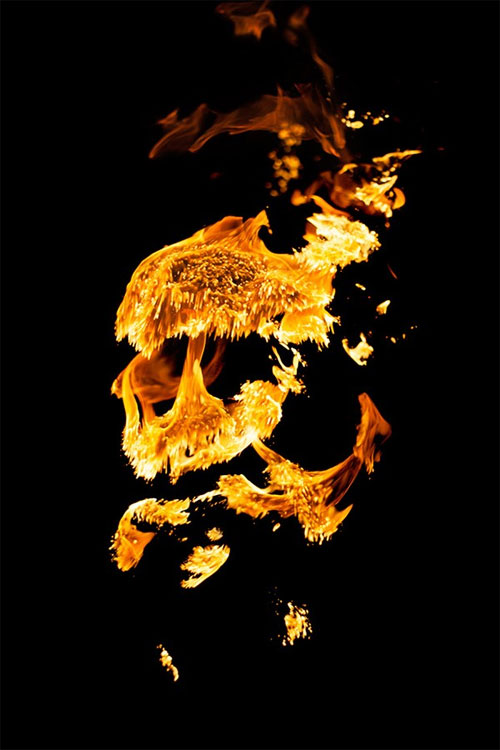See the types of war weapons
Learn about the destructive power of war weapons like H bombs, napalm bombs . when exploding.
French artist - Alain Declercq has recorded a simple image of the explosion of various chemical compounds used for many types of war weapons such as TNT, napalm, bomb H .
After recording the image of the "explosion", Declercq adjusted the light intensity, placed on a black background to enhance the visual effect. For the author, each picture is like a strong comment about the destructive power of the bombs used in world war.
H bomb

H-bombs (hydrogen bombs, hydrogen bombs) are nuclear weapons that produce enormous energy from nuclear fusion (also known as fusion). The temperature at the center of the explosive area is 1,000 times greater than the Sun's temperature.
In just 90 seconds, the "white mushroom column" with tremendous heat flared 17km. A powerful dose of radiation will hit normal people in a 4.7km radius from the center of the explosion. This effect is enough to cause 90% of people exposed to radiation to face the risk of death, if not killed by heat or shock waves created by the explosion.
Napan bomb

Napkin is a fire bomb, with strong damage. Napan bombs that use oil always stick to the human body and burn at very high temperatures (about 800 - 1,000 degrees) causing severe burns.
The melting temperature of Napan bombs is 900 - 1,300 degrees within 3 - 15 minutes. When outbreaks occur, quicksorption of oxygen in the air is rapidly absorbed, while a large amount of CO can cause suffocation.
Phosphorus bomb

The destructive power of this bomb is much higher than the napalm bomb. White phosphorus is very flammable, when it is exposed to air at normal temperature it also automatically ignites (due to oxygen).
The fire of white phosphorus is very dangerous to humans. When sticky, phosphorus will cause severe burns due to its ability to penetrate deep into the human body to the bone, weaving into the tissues inside the body and destroying them.
TNT

TNT is one of the most popular explosives for military and industrial applications. TNT melts at 80 degrees Celsius, much lower than the temperature it detonates on its own, so it can be safely mixed with other explosives. The killing power of TNT is about 4,200 - 7,000 m / s.
Plastic explosive C4

C4 plastic explosives with easy-to-mold and powerful properties than TNT should often be stuffed into bullets used to destroy buildings. The killing power of C4 plastic explosive is 7.380m / s. This explosive will automatically explode at a temperature of 202 degrees C or higher.
- 5 types of weapons that killed millions of people during World War I
- 4 types of weapons of separation of powerful and scary tribes in history
- 1001 types of self-defense of marine animals
- Revealing techniques for manufacturing ancient weapons from 77,000 years ago
- Ancient weapons of destruction
- The most feared nuclear weapons systems in the world
- The US Army expects to shoot down aircraft with counter-air laser weapons
- Process of decontamination from weapons of mass destruction by the US military
- Special weapons of great benefit
- Secret secret weapon used to assassinate during World War 2
- 'Network weapon': Indispensable in the UK arsenal
- Vietnam successfully upgraded the Kh-29 missile
 'Fine laughs' - Scary and painful torture in ancient times
'Fine laughs' - Scary and painful torture in ancient times The sequence of numbers 142857 of the Egyptian pyramids is known as the strangest number in the world - Why?
The sequence of numbers 142857 of the Egyptian pyramids is known as the strangest number in the world - Why? History of the iron
History of the iron What is alum?
What is alum? Bombs left over from the World War are increasingly explosive
Bombs left over from the World War are increasingly explosive  Convention on weapons used in war
Convention on weapons used in war  The smaller the fart is, the more it smells, is it right or wrong?
The smaller the fart is, the more it smells, is it right or wrong?  Differences between atomic bombs and fusion
Differences between atomic bombs and fusion  Slowly mass-killing bombs that terrify the world
Slowly mass-killing bombs that terrify the world  American bizarre bombs only kill people, do not destroy houses
American bizarre bombs only kill people, do not destroy houses 